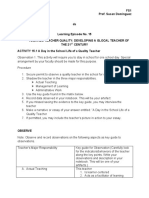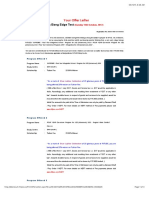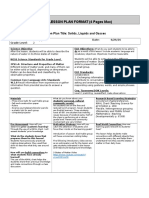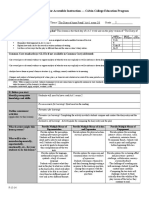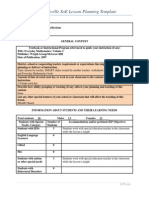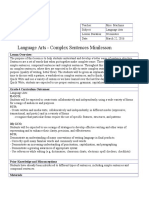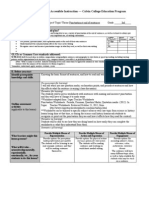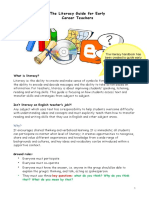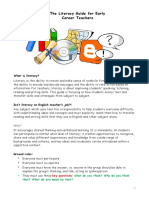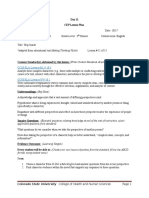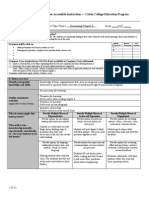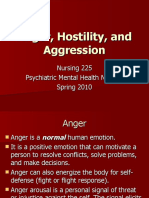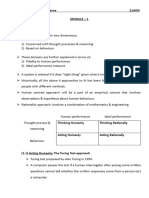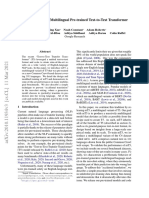Flipped Class Lesson Plan
Flipped Class Lesson Plan
Uploaded by
api-273163460Copyright:
Available Formats
Flipped Class Lesson Plan
Flipped Class Lesson Plan
Uploaded by
api-273163460Original Title
Copyright
Available Formats
Share this document
Did you find this document useful?
Is this content inappropriate?
Copyright:
Available Formats
Flipped Class Lesson Plan
Flipped Class Lesson Plan
Uploaded by
api-273163460Copyright:
Available Formats
Flipped Class Lesson Plan
Lesson Title: Sentence Variation
Targeted Grade Level: Secondary (6-8) - ELL Students
Subject: English Language Arts
Time Period: 2-3 days
Lesson Objectives: (Blooms Correlated)
The learner will recall parts of speech such as nouns and verbs.
The learner will understand how parts of speech and punctuation create simple,
compound, and complex sentences.
The learner will analyze the characteristics of a simple, compound, and complex
sentence.
The learner will apply their findings to the process of writing.
Materials/Resources Needed:
Engagement Activity (the activity that the students will do at home to introduce the
lesson)
At home assessment (quizlet.com)
Anchor Chart and markers
Magazines
What Marzano strategies will you use to help students process information?
Homework and Practice- students will have various chances to practice in order to extend
their learning outside of the classroom (ex: Instruct the students to use simple, compound,
and complex sentences when using written communication i.e. text or email)
Non-linguistic Representation- Words and images are used to symbolize and represent
what is being taught (ex: FANBOYS, Wabu Wabu Waties, Adult, Couple, Baby)
What will you do in class the previous day? (Engagement)
Give the students the terms that they should try and define as they look at the sketchcast
such as: simple, compound, complex sentences, coordinate and subordinate conjunction.
The teacher will assign the engagement activity for homework prior to teaching the
lesson.
What will the students do at home? (Explanation)
The students will watch the sketchcast video (engagement activity) and define the given
words.
The words should be brought in to class to begin the classroom opening discussion.
What will be done in class on the following day? (Elaboration & Exploration)
An opening discussion will occur asking, What are the characteristics of each type of
sentence?
Create 3 anchor charts and list this as: Simple Sentence, Compound Sentence, Complex
Sentence
As the students give feedback of the sentence characteristics you will write it on the
designated anchor chart
To further observe students understanding the students will work in groups to create a
simple, compound, and complex collage using sentences found in magazines.
Leave your class with the question of How can we apply this knowledge into our
everyday lives?
How will you assess student learning? (Evaluation)
Wrap up the lesson with an at home assessment.
Extension:
If you receive data from the home assessment that is unacceptable, have a class
discussion about what they did not understand.
Continue the lesson with warm-ups.
Conduct another assessment within 3-5 days.
You might also like
- Voices Elementary TeachersBook Unit Notes All UnitsDocument223 pagesVoices Elementary TeachersBook Unit Notes All UnitsEricson TimanaNo ratings yet
- UbD LessonPlanDocument5 pagesUbD LessonPlanht00630No ratings yet
- Reading and Test Strategies Mini Lesson Formal 3Document6 pagesReading and Test Strategies Mini Lesson Formal 3api-319041284No ratings yet
- Reflective Lesson Plan 6Document7 pagesReflective Lesson Plan 6api-252760395No ratings yet
- Madeline Hunter Lesson Plan ParagraphsDocument3 pagesMadeline Hunter Lesson Plan Paragraphsapi-352928743100% (1)
- Teacher Book For Online English TeachersDocument47 pagesTeacher Book For Online English TeachersYander Marl Bautista100% (1)
- Learning-Episode15 Ricafrente AngelaDocument4 pagesLearning-Episode15 Ricafrente AngelaLady Valerie Golpo70% (30)
- 21st CenLit Module 5Document18 pages21st CenLit Module 5Roble Shine Francine67% (3)
- The Development of Mathematics Curriculum in MalaysiaDocument2 pagesThe Development of Mathematics Curriculum in MalaysiaAnonymous RQBZGYwNo ratings yet
- Big Bang Edge Test: Your Offer LetterDocument4 pagesBig Bang Edge Test: Your Offer LetterShubham AwasthiNo ratings yet
- Diversity LessonDocument5 pagesDiversity Lessonapi-254206113No ratings yet
- Edtpa Lesson Plan Format (4 Pages Max)Document5 pagesEdtpa Lesson Plan Format (4 Pages Max)api-28847298No ratings yet
- Photo Scavenger HuntDocument4 pagesPhoto Scavenger HuntBri AnthonyNo ratings yet
- TechlessonplanDocument4 pagesTechlessonplanapi-284926914No ratings yet
- Lesson Plan 3 Educ 302Document8 pagesLesson Plan 3 Educ 302api-315445685No ratings yet
- Tws - LessonDocument15 pagesTws - Lessonapi-282027876No ratings yet
- EDUC 2220-Educational Technology Lesson Plan TemplateDocument4 pagesEDUC 2220-Educational Technology Lesson Plan TemplateCamaryn CornuteNo ratings yet
- Lesson Plan Observation 1Document6 pagesLesson Plan Observation 1api-702381076No ratings yet
- Lesson PlanDocument4 pagesLesson Planapi-242250154No ratings yet
- 4math Lesson 10 3Document5 pages4math Lesson 10 3api-236893416No ratings yet
- Lesson Plan Design: Ccss - Ela-Literacy - Rf.2.3Document6 pagesLesson Plan Design: Ccss - Ela-Literacy - Rf.2.3api-323520361No ratings yet
- Phrases and Clauses Solo Lesson PlanDocument4 pagesPhrases and Clauses Solo Lesson Planapi-5340974790% (1)
- Reflective Lesson Plan (HoneyBees)Document7 pagesReflective Lesson Plan (HoneyBees)jmccrea92No ratings yet
- TOSD Endorsement Program Danielson Framework Lesson Plan TemplateDocument6 pagesTOSD Endorsement Program Danielson Framework Lesson Plan Templateapi-242556681No ratings yet
- Lesson Plans - Task RotationDocument2 pagesLesson Plans - Task Rotationapi-359783311100% (1)
- Lesson Plan Form - LBS 400: Candidate: Subject: Grade Level(s) : DateDocument6 pagesLesson Plan Form - LBS 400: Candidate: Subject: Grade Level(s) : Dateapi-384805212No ratings yet
- Edma3200 Lesson5practicumDocument3 pagesEdma3200 Lesson5practicumapi-252533855No ratings yet
- Complex Sentences Lessonplan1Document7 pagesComplex Sentences Lessonplan1api-310531318No ratings yet
- STEPP Lesson Plan Form: Content Standard(s) Addressed by This LessonDocument6 pagesSTEPP Lesson Plan Form: Content Standard(s) Addressed by This Lessonapi-264548225No ratings yet
- Example Lesson PlansDocument15 pagesExample Lesson Plansapi-289863780No ratings yet
- Daily Lesson Plans 12th Grade 341Document3 pagesDaily Lesson Plans 12th Grade 341Aiman Suhaimi100% (1)
- Edu 276 LessonplanDocument6 pagesEdu 276 Lessonplanapi-341316035No ratings yet
- Learning Segment-Ela 2Document10 pagesLearning Segment-Ela 2api-254944388No ratings yet
- Lesson PlanDocument4 pagesLesson Planapi-220292228No ratings yet
- Technology Lesson Plan TemplateDocument3 pagesTechnology Lesson Plan Templateapi-248376092No ratings yet
- Literacy HandbookDocument16 pagesLiteracy Handbookapi-299191866No ratings yet
- Peer Review Lesson PlanDocument5 pagesPeer Review Lesson Planapi-269729950No ratings yet
- Lesson PlanDocument16 pagesLesson Planapi-254506729No ratings yet
- Leeannapekel Edu707 Unit6 - 1Document16 pagesLeeannapekel Edu707 Unit6 - 1api-264288306No ratings yet
- Step 3 Lesson Plan FormDocument4 pagesStep 3 Lesson Plan Formapi-404782446No ratings yet
- Unit Plan 1-5Document21 pagesUnit Plan 1-5api-326620154No ratings yet
- Tiered Lesson Plan and AppendiciesDocument7 pagesTiered Lesson Plan and Appendiciesapi-295583127No ratings yet
- Adding Lesson PlanDocument4 pagesAdding Lesson Planapi-527752646No ratings yet
- Task 3Document3 pagesTask 3api-396133967No ratings yet
- Unit 6Document4 pagesUnit 6api-245823147No ratings yet
- Design Topic Sentence Structure Subject(s) - English Grade(s) - 2 Designer(s) Becca Roberts Understanding by DesignDocument7 pagesDesign Topic Sentence Structure Subject(s) - English Grade(s) - 2 Designer(s) Becca Roberts Understanding by Designapi-294708096No ratings yet
- Recess Lesson PlanDocument8 pagesRecess Lesson Planapi-425637153No ratings yet
- Team 3 Lesson Plan FinalDocument7 pagesTeam 3 Lesson Plan Finalapi-272893415No ratings yet
- Literacy HandbookDocument16 pagesLiteracy Handbookapi-299191866No ratings yet
- Living Forever Lesson PlanDocument6 pagesLiving Forever Lesson Planapi-425637153No ratings yet
- Mini Lesson Plan 3: Lesson Plan Title: Parts of A House With Dyslexia AdaptationsDocument4 pagesMini Lesson Plan 3: Lesson Plan Title: Parts of A House With Dyslexia Adaptationsapi-260889954No ratings yet
- Language January 23, 2023Document13 pagesLanguage January 23, 2023Omar GollabNo ratings yet
- CEP Lesson Plan Form: CCSS - ELA-Literacy - RL.9-10.3Document11 pagesCEP Lesson Plan Form: CCSS - ELA-Literacy - RL.9-10.3api-309656697No ratings yet
- Vân's CommentsDocument23 pagesVân's Comments227140231037No ratings yet
- Millicent Atkins School of Education: Common Lesson Plan Template PlanningDocument9 pagesMillicent Atkins School of Education: Common Lesson Plan Template Planningapi-331892318No ratings yet
- Unit Plan 6-10Document20 pagesUnit Plan 6-10api-326620154No ratings yet
- Lesson Planning Form For Accessible Instruction - Calvin College Education ProgramDocument4 pagesLesson Planning Form For Accessible Instruction - Calvin College Education Programapi-339549780No ratings yet
- Reflective Lesson Plan Model Rubric - 450 - Revised 2013Document7 pagesReflective Lesson Plan Model Rubric - 450 - Revised 2013dburns1No ratings yet
- 9.3 Communicating About Our World Through Informational TextDocument5 pages9.3 Communicating About Our World Through Informational TextMarilu Velazquez MartinezNo ratings yet
- Lesson 3Document3 pagesLesson 3api-245823147No ratings yet
- Lesson Plan Template - Set ProgramDocument4 pagesLesson Plan Template - Set Programapi-238367895No ratings yet
- Part A: Assessment Task: ETP425 Teaching and Learning 3 Assignment Task: Assessment For and of LearningDocument6 pagesPart A: Assessment Task: ETP425 Teaching and Learning 3 Assignment Task: Assessment For and of Learningapi-172277450No ratings yet
- Informational Text Toolkit: Research-based Strategies for the Common Core StandardsFrom EverandInformational Text Toolkit: Research-based Strategies for the Common Core StandardsNo ratings yet
- Topic 1Document8 pagesTopic 1Anja RistauNo ratings yet
- Lesson 1 Introduction To ResearchDocument8 pagesLesson 1 Introduction To Researchneojohn05No ratings yet
- Yegna 1999Document479 pagesYegna 1999Akanksha SinghNo ratings yet
- Anger, Hostility, and Aggression Lecture VersionDocument65 pagesAnger, Hostility, and Aggression Lecture Versionsheliafoster50% (2)
- Nesvjesne Ego OdbraneDocument27 pagesNesvjesne Ego OdbraneNađa FilipovićNo ratings yet
- ACR English Month 2023Document3 pagesACR English Month 2023Ylandie aukieNo ratings yet
- What Is AIDocument3 pagesWhat Is AISiju V SomanNo ratings yet
- Research Essay For Plain English in LegaDocument28 pagesResearch Essay For Plain English in Legaابو ريمNo ratings yet
- System Lifecycle Questions in IGCSEDocument5 pagesSystem Lifecycle Questions in IGCSESamuel Jashar a/l S KunaratnamNo ratings yet
- 2007 ElliotMaierMollerFriedmanMeinhardt ColorDocument16 pages2007 ElliotMaierMollerFriedmanMeinhardt ColorBrian MejiaNo ratings yet
- Q2 Lesson 6.2 ARGUMENTATIVE SPEECHDocument26 pagesQ2 Lesson 6.2 ARGUMENTATIVE SPEECHJamMelchor0% (1)
- Changing Ideas of Beauty: Lesson PlanDocument4 pagesChanging Ideas of Beauty: Lesson PlanJose AntonioNo ratings yet
- SP Iii-38Document4 pagesSP Iii-38Antonio SearesNo ratings yet
- Iana Codruta PsyhearchitectureDocument12 pagesIana Codruta PsyhearchitectureCodrutza IanaNo ratings yet
- English 10 Q2 Module 3 Formulating A Statement of Assertion or Opinion EDITED 13PAGESDocument13 pagesEnglish 10 Q2 Module 3 Formulating A Statement of Assertion or Opinion EDITED 13PAGESJeneva CatalogoNo ratings yet
- Basic Public Speaking Two Text D Parker PDF-2Document224 pagesBasic Public Speaking Two Text D Parker PDF-2Vista Music SchoolNo ratings yet
- CV and Cover Letter Guide: Career Development CentreDocument26 pagesCV and Cover Letter Guide: Career Development CentreZhanXiongNo ratings yet
- DLP - Perdev - 10-23-24 - Goatherd-Wild GoatsDocument4 pagesDLP - Perdev - 10-23-24 - Goatherd-Wild GoatslyramitchaoNo ratings yet
- Nurindah-Lelly-Nggawu-ESP JOURNAL June 2019 Vol 5 Issue 1.2 ENPDocument25 pagesNurindah-Lelly-Nggawu-ESP JOURNAL June 2019 Vol 5 Issue 1.2 ENPDaniela LeónNo ratings yet
- Enc 1101 ReflectionDocument4 pagesEnc 1101 Reflectionapi-273578333No ratings yet
- LARDIZABAL H. ResearchDocument32 pagesLARDIZABAL H. ResearchKlaris Reyes0% (1)
- Media EYLDocument13 pagesMedia EYLRahmi HidayahNo ratings yet
- 2021 Multilingual-T5 Xue-GoogleDocument17 pages2021 Multilingual-T5 Xue-Googlerajesh716No ratings yet
- Philip Manfield-Split Self - Split Object - Understanding and Treating Borderline, Narcissistic, and Schizoid Disorders-Jason Aronson Inc. (1992) PDFDocument392 pagesPhilip Manfield-Split Self - Split Object - Understanding and Treating Borderline, Narcissistic, and Schizoid Disorders-Jason Aronson Inc. (1992) PDFCristina Mitroi83% (6)








